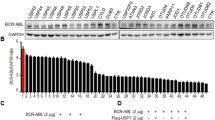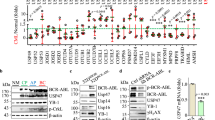Abstract
Imatinib is the leading compound to treat patients with chronic myelogenous leukemia (CML) but the exact mechanism of its anti-leukemic effect is incompletely elucidated. Through inhibition of BCR–ABL, Imatinib blocks several downstream pathways and induces apoptosis of BCR–ABL positive cells. In this study, we analyzed further the mode of action of Imatinib in different appropriate cellular models of CML either sensitive or resistant to Imatinib and in CD34+ cells from CML patients. Pharmacological or short hairpin RNA-mediated inhibition of BCR–ABL triggers lysosomal membrane permeabilization (LMP) that culminates in activation and redistribution of Cathepsin B (CB) into the cytoplasm of CML cells, in which it triggers directly BCR–ABL degradation. Pharmacological inhibition of CB by CA-074Me or small interfering RNA-mediated knock-down of CB partly protects K562 cells from Imatinib-induced cell death and CB overexpression sensitizes these cells to Imatinib killing. Strikingly, Imatinib-triggered LMP, CB activation and BCR–ABL cleavage in CD34+ cells from CML patients and inhibition of CB confers protection against cell death in clonogenic assays of CD34+ primary cells from CML patients. Hence, we describe an original pathway by which Imatinib participates to the elimination of CML cells through LMP and CB-mediated specific degradation of BCR–ABL.
This is a preview of subscription content, access via your institution
Access options
Subscribe to this journal
Receive 12 print issues and online access
$259.00 per year
only $21.58 per issue
Buy this article
- Purchase on Springer Link
- Instant access to full article PDF
Prices may be subject to local taxes which are calculated during checkout






Similar content being viewed by others
References
Heisterkamp N, Stephenson JR, Groffen J, Hansen PF, de Klein A, Bartram CR et al. Localization of the c-ab1 oncogene adjacent to a translocation break point in chronic myelocytic leukaemia. Nature 1983; 306: 239–242.
Groffen J, Stephenson JR, Heisterkamp N, de Klein A, Bartram CR, Grosveld G . Philadelphia chromosomal breakpoints are clustered within a limited region, bcr, on chromosome 22. Cell 1984; 36: 93–99.
Deininger MW, Goldman JM, Melo JV . The molecular biology of chronic myeloid leukemia. Blood 2000; 96: 3343–3356.
Steelman LS, Pohnert SC, Shelton JG, Franklin RA, Bertrand FE, McCubrey JA . JAK/STAT, Raf/MEK/ERK, PI3K/Akt and BCR-ABL in cell cycle progression and leukemogenesis. Leukemia 2004; 18: 189–218.
Dan S, Naito M, Tsuruo T . Selective induction of apoptosis in Philadelphia chromosome-positive chronic myelogenous leukemia cells by an inhibitor of BCR - ABL tyrosine kinase, CGP 57148. Cell Death Differ 1998; 5: 710–715.
Fang G, Kim CN, Perkins CL, Ramadevi N, Winton E, Wittmann S et al. CGP57148B (STI-571) induces differentiation and apoptosis and sensitizes Bcr-Abl-positive human leukemia cells to apoptosis due to antileukemic drugs. Blood 2000; 96: 2246–2253.
Luciano F, Jacquel A, Colosetti P, Herrant M, Cagnol S, Pages G et al. Phosphorylation of Bim-EL by Erk1/2 on serine 69 promotes its degradation via the proteasome pathway and regulates its proapoptotic function. Oncogene 2003; 22: 6785–6793.
Kuroda J, Puthalakath H, Cragg MS, Kelly PN, Bouillet P, Huang DC et al. Bim and Bad mediate imatinib-induced killing of Bcr/Abl+ leukemic cells, and resistance due to their loss is overcome by a BH3 mimetic. Proc Natl Acad Sci USA 2006; 103: 14907–14912.
Okada M, Adachi S, Imai T, Watanabe K, Toyokuni SY, Ueno M et al. A novel mechanism for imatinib mesylate-induced cell death of BCR-ABL-positive human leukemic cells: caspase-independent, necrosis-like programmed cell death mediated by serine protease activity. Blood 2004; 103: 2299–2307.
Jacquel A, Colosetti P, Grosso S, Belhacene N, Puissant A, Marchetti S et al. Apoptosis and erythroid differentiation triggered by Bcr-Abl inhibitors in CML cell lines are fully distinguishable processes that exhibit different sensitivity to caspase inhibition. Oncogene 2007; 26: 2445–2458.
Bredesen DE, Rao RV, Mehlen P . Cell death in the nervous system. Nature 2006; 443: 796–802.
Ferri KF, Kroemer G . Organelle-specific initiation of cell death pathways. Nat Cell Biol 2001; 3: E255–E263.
Kroemer G, Jaattela M . Lysosomes and autophagy in cell death control. Nat Rev Cancer 2005; 5: 886–897.
Cirman T, Oresic K, Mazovec GD, Turk V, Reed JC, Myers RM et al. Selective disruption of lysosomes in HeLa cells triggers apoptosis mediated by cleavage of Bid by multiple papain-like lysosomal cathepsins. J Biol Chem 2004; 279: 3578–3587.
Boya P, Andreau K, Poncet D, Zamzami N, Perfettini JL, Metivier D et al. Lysosomal membrane permeabilization induces cell death in a mitochondrion-dependent fashion. J Exp Med 2003; 197: 1323–1334.
Droga-Mazovec G, Bojic L, Petelin A, Ivanova S, Romih R, Repnik U et al. Cysteine cathepsins trigger caspase-dependent cell death through cleavage of bid and antiapoptotic Bcl-2 homologues. J Biol Chem 2008; 283: 19140–19150.
Kamitsuji Y, Kuroda J, Kimura S, Toyokuni S, Watanabe K, Ashihara E et al. The Bcr-Abl kinase inhibitor INNO-406 induces autophagy and different modes of cell death execution in Bcr-Abl-positive leukemias. Cell Death Differ 2008; 15: 1712–1722.
Mahon FX, Deininger MW, Schultheis B, Chabrol J, Reiffers J, Goldman JM et al. Selection and characterization of BCR-ABL positive cell lines with differential sensitivity to the tyrosine kinase inhibitor STI571: diverse mechanisms of resistance. Blood 2000; 96: 1070–1079.
Herrant M, Jacquel A, Marchetti S, Belhacene N, Colosetti P, Luciano F et al. Cleavage of Mcl-1 by caspases impaired its ability to counteract Bim-induced apoptosis. Oncogene 2004; 23: 7863–7873.
Jacquel A, Herrant M, Legros L, Belhacene N, Luciano F, Pages G et al. Imatinib induces mitochondria-dependent apoptosis of the Bcr-Abl-positive K562 cell line and its differentiation toward the erythroid lineage. Faseb J 2003; 17: 2160–2162.
Puissant A, Grosso S, Jacquel A, Belhacene N, Colosetti P, Cassuto JP et al. Imatinib mesylate-resistant human chronic myelogenous leukemia cell lines exhibit high sensitivity to the phytoalexin resveratrol. Faseb J 2008; 5: 5.
Kohmura K, Miyakawa Y, Kawai Y, Ikeda Y, Kizaki M . Different roles of p38 MAPK and ERK in STI571-induced multi-lineage differentiation of K562 cells. J Cell Physiol 2004; 198: 370–376.
Kawano T, Horiguchi-Yamada J, Iwase S, Furukawa Y, Kano Y, Yamada H . Inactivation of ERK accelerates erythroid differentiation of K562 cells induced by herbimycin A and STI571 while activation of MEK1 interferes with it. Mol Cell Biochem 2004; 258: 25–33.
Rangatia J, Bonnet D . Transient or long-term silencing of BCR-ABL alone induces cell cycle and proliferation arrest, apoptosis and differentiation. Leukemia 2006; 20: 68–76.
Mohamed MM, Sloane BF . Cysteine cathepsins: multifunctional enzymes in cancer. Nat Rev Cancer 2006; 6: 764–775.
Ertmer A, Huber V, Gilch S, Yoshimori T, Erfle V, Duyster J et al. The anticancer drug imatinib induces cellular autophagy. Leukemia 2007; 21: 936–942.
Bellodi C, Lidonnici MR, Hamilton A, Helgason GV, Soliera AR, Ronchetti M et al. Targeting autophagy potentiates tyrosine kinase inhibitor-induced cell death in Philadelphia chromosome-positive cells, including primary CML stem cells. J Clin Invest 2009; 119: 1109–1123.
Stoka V, Turk B, Schendel SL, Kim TH, Cirman T, Snipas SJ et al. Lysosomal protease pathways to apoptosis. Cleavage of bid, not pro-caspases, is the most likely route. 2001; 276: 3149–3157.
Tanida I, Minematsu-Ikeguchi N, Ueno T, Kominami E . Lysosomal turnover, but not a cellular level, of endogenous LC3 is a marker for autophagy. Autophagy 2005; 1: 84–91.
Barila D, Rufini A, Condo I, Ventura N, Dorey K, Superti-Furga G et al. Caspase-dependent cleavage of c-Abl contributes to apoptosis. Mol Cell Biol 2003; 23: 2790–2799.
Kitareewan S, Roebuck BD, Demidenko E, Sloboda RD, Dmitrovsky E . Lysosomes and trivalent arsenic treatment in acute promyelocytic leukemia. J Natl Cancer Inst 2007; 99: 41–52.
Erdal H, Berndtsson M, Castro J, Brunk U, Shoshan MC, Linder S . Induction of lysosomal membrane permeabilization by compounds that activate p53-independent apoptosis. Proc Natl Acad Sci USA 2005; 102: 192–197.
Ivanov A, Beers SA, Walshe CA, Honeychurch J, Alduaij W, Cox KL et al. Monoclonal antibodies directed to CD20 and HLA-DR can elicit homotypic adhesion followed by lysosome-mediated cell death in human lymphoma and leukemia cells. J Clin Invest 2009; 119: 2143–2159.
Acknowledgements
We are indebted to clinician colleagues from CHU and Centre Antoine Lacassagne of Nice, and Centre Hospitalier Princesse Grace of Monaco, for their generosity in providing patient samples. We also thank the patients enrolled in this study. We thank Dr H Clevers, at the Hubrecht Laboratory, Utrecht, The Netherlands for the pTer plasmid for inducible shRNA expression. We are indebted to Professor JV Melo at the Imperial College of London, UK and Professor FX Mahon, INSERM U876 Bordeaux, France for the kind gift of parental Baf/3 cells and Baf/3 cells carrying the T315I mutation. This work was also supported by The Institute National des Canceropoles (INCA 2006 PL-026). GR is the recipient from an INCA fellowship.
Author information
Authors and Affiliations
Corresponding author
Additional information
Supplementary Information accompanies the paper on the Leukemia website (http://www.nature.com/leu)
Rights and permissions
About this article
Cite this article
Puissant, A., Colosetti, P., Robert, G. et al. Cathepsin B release after imatinib-mediated lysosomal membrane permeabilization triggers BCR–ABL cleavage and elimination of chronic myelogenous leukemia cells. Leukemia 24, 115–124 (2010). https://doi.org/10.1038/leu.2009.233
Received:
Revised:
Accepted:
Published:
Issue Date:
DOI: https://doi.org/10.1038/leu.2009.233
Keywords
This article is cited by
-
AML1-ETO targets and suppresses cathepsin G, a serine protease, which is able to degrade AML1-ETO in t(8;21) acute myeloid leukemia
Oncogene (2013)
-
Pazopanib and sunitinib trigger autophagic and non-autophagic death of bladder tumour cells
British Journal of Cancer (2013)
-
Killing a cancer: what are the alternatives?
Nature Reviews Cancer (2012)
-
Apoptosis and autophagy have opposite roles on imatinib-induced K562 leukemia cell senescence
Cell Death & Disease (2012)
-
Targeting lysosomes to eradicate imatinib-resistant chronic myelogenous leukemia cells
Leukemia (2010)



